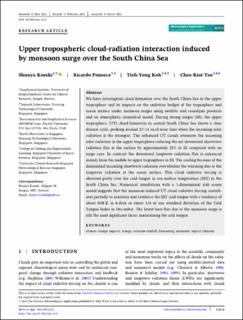| dc.contributor.author | Koseki, Shunya | |
| dc.contributor.author | Fonseca, Ricardo | |
| dc.contributor.author | Koh, Tieh-Yong | |
| dc.contributor.author | Teo, Chee-Kiat | |
| dc.date.accessioned | 2023-07-04T11:44:04Z | |
| dc.date.available | 2023-07-04T11:44:04Z | |
| dc.date.created | 2023-05-22T10:19:14Z | |
| dc.date.issued | 2023 | |
| dc.identifier.issn | 1350-4827 | |
| dc.identifier.uri | https://hdl.handle.net/11250/3075553 | |
| dc.description.abstract | We have investigated cloud formation over the South China Sea in the upper troposphere and its impacts on the radiation budget of the troposphere and ocean surface under monsoon surges using satellite and reanalysis products and an atmospheric numerical model. During strong surges (SS), the upper tropospheric (UT) cloud formation in central South China Sea shows a clear diurnal cycle, peaking around 12–14 local solar time when the incoming solar radiation is the strongest. The enhanced UT clouds attenuate the incoming solar radiation in the upper troposphere reducing the net downward shortwave radiation flux at the surface by approximately 28% in SS compared with no surge case. In contrast the downward longwave radiation flux is enhanced mainly from the middle to upper troposphere in SS. The cooling because of the diminished incoming shortwave radiation overwhelms the warming due to the longwave radiation at the ocean surface. This cloud radiative forcing is observed partly over the cold tongue in sea surface temperature (SST) in the South China Sea. Numerical simulations with a 1-dimensional slab ocean model suggests that the monsoon-induced UT cloud radiative forcing contributes partially to maintain and reinforce the SST cold tongue with a tendency of about 0.08 K in 6 days or about 1/6 of one standard deviation of the Cold Tongue Index in December. The latent heat flux due to the monsoon surge is still the most significant factor maintaining the cold tongue. | en_US |
| dc.language.iso | eng | en_US |
| dc.publisher | Wiley | en_US |
| dc.rights | Navngivelse 4.0 Internasjonal | * |
| dc.rights.uri | http://creativecommons.org/licenses/by/4.0/deed.no | * |
| dc.title | Upper tropospheric cloud-radiation interaction induced by monsoon surge over the South China Sea | en_US |
| dc.type | Journal article | en_US |
| dc.type | Peer reviewed | en_US |
| dc.description.version | publishedVersion | en_US |
| dc.rights.holder | Copyright 2023 The Author(s) | en_US |
| dc.source.articlenumber | e2125 | en_US |
| cristin.ispublished | true | |
| cristin.fulltext | original | |
| cristin.qualitycode | 1 | |
| dc.identifier.doi | 10.1002/met.2125 | |
| dc.identifier.cristin | 2148381 | |
| dc.source.journal | Meteorological Applications | en_US |
| dc.identifier.citation | Meteorological Applications. 2023, 30 (2), e2125. | en_US |
| dc.source.volume | 30 | en_US |
| dc.source.issue | 2 | en_US |

